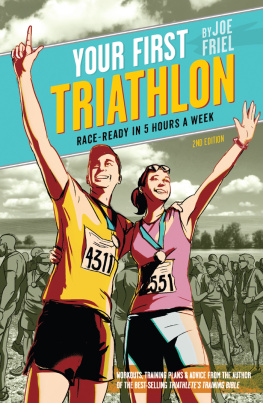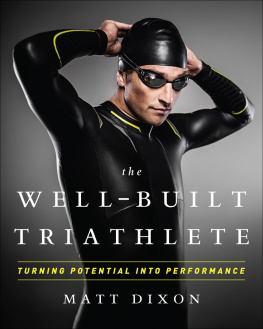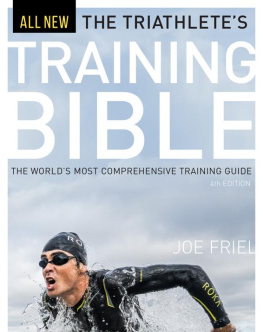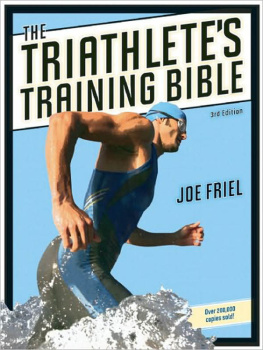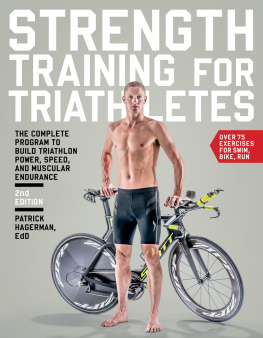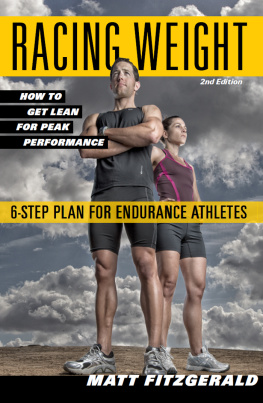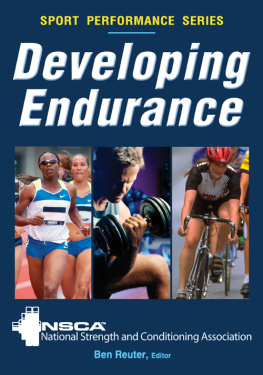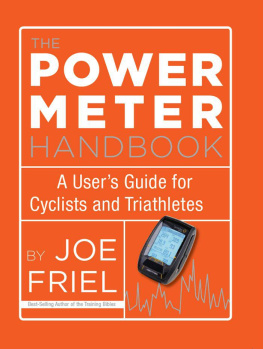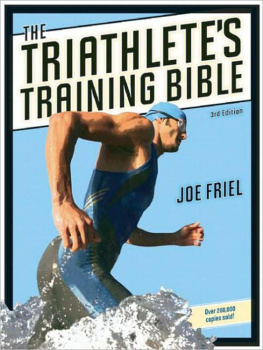

Copyright 2015 by Joe Friel
All rights reserved. Published in the United States of America by VeloPress, a division of Competitor Group, Inc.
Ironman is a registered trademark of World Triathlon Corporation.

3002 Sterling Circle, Suite 100
Boulder, Colorado 80301-2338 USA
(303) 440-0601 Fax (303) 444-6788 E-mail
Distributed in the United States and Canada by Ingram Publisher Services
A Cataloging-in-Publication Data record for the printed edition is on file with the Library of Congress.
ISBN 978-1-937715-26-7 (pbk); ISBN 978-1-937716-69-1 (e-book)
For information on purchasing VeloPress books, please call (800) 811-4210, ext. 2138, or visit www.velopress.com.
Cover design by Kevin Roberson
Cover illustration by Alex Williamson
Cover photograph by Philip Beckman
v. 3.1
A note to readers: Move the cursor over the art and click on it to enlarge.
For all of the older athletes Ive known and coached.
Thank you for being role models and teachers
for so many younger athletes.
CONTENTS
Mark Allen
Andrew Pruitt, EdD
Larry Creswell, MD
Lisa Rainsberger
Ned Overend
John Post, MD
Amby Burfoot
John Howard
Tim Noakes, MD
Gale Bernhardt
Im 70.
There. Ive said it.
That dreaded birthday arrived shortly after I started writing this book. None of my previous many-candle birthdays40, 50, or even 60got my attention. But 70 did. Somehow, 70 seems really old, a lot older than 69. It seemed different enough to me that I had been contemplating the start of my eighth decade of life for the better part of a year. My greatest concern was that it might signal the beginning of the end of my lifelong adventure as a serious athlete. I simply didnt know what to expect.
Six months prior to the Big Day, I decided to do something about it. I was going to read all of the aging research I could find to see if I could determine my future as an old athlete. I also wanted to learn what I could do to avoid a big decline in performance. The last time I read the aging research was in the mid-1990s when I wrote a book titled Cycling Past 50. I was 53 at the time. There wasnt much research on aging available back then. But with the huge baby-boom generation entering their 60s starting in 2005 and the impact of their arrival en masse on American life, I found that this picture had changed considerably.
In the past 15 years or so, a tremendous amount of research on aging had been done. I read those studies almost daily for the better part of a year. I started seeing interesting patterns in them. And so in the late summer of 2013, only a few months into the project, I decided to write a blog about what I was learning. That turned into 29 posts (www.joefrielsblog.com) on the topic of aging, which drew a great deal of positive feedback from readers. The tremendous response from older athletes convinced me that I needed to write a book on the topic to reach a bigger audience and tell them what I had learned. As it turned out, my publisher, VeloPress, had been looking for someone to write such a book.
You now have in your hands my personal birthday present for all senior athletes. I hope it helps you answer your questions about aging, which I am sure are the same questions that I had at the start of the project. Of course, theres only one question we all want the answer to, the same one I pondered prior to my Big Seven-Zero Day: How can I slow, or perhaps even temporarily reverse, the loss of performance as I get older?
By the time were in our 50s, its just starting to become apparent that things are going the wrong way. The first thing athletes typically notice around that age is that they dont recover from a race or a hard training session as quickly as they did a few years earlier. And not only thatrace times are slowing, theres a loss of power, hills seem steeper, and other performance markers are also looking worse. What can be done?
My purpose in writing this book is to help you answer that question by coming to understand what sport science says about the senior athletes performance, training, and lifestyle. If youve already thumbed through the pages, youve probably noticed two things: There are lots of numbered notes in the text, and they lead to scientific sources that are collected by chapter at the end of the book. You may not be used to reading books like this. At first glance, this level of source citation may make the book look more like a college textbook than an entertaining read. But Ive included those notes and references for a reason. I believe it is necessary to provide some degree of proof about what I am proposing you do in your training to improve performance, rather than just offering unvalidated opinions.
There are two basic sources of information about aging: research and opinion. Both are valuable in some way. When it comes to the value of opinion, it depends on the source. Is the source knowledgeable and experienced with a long history of working with aging athletes and endurance sports? Does the opinion come from someone who also is an aging athlete? Or are you reading the opinion of someone who has very little background in sport, knows little about physiology, and is talking off the top of his or her head with nothing to back it up? I highly value the opinions of a few known, learned people, but pay little attention to the ramblings of most on this and related topics. Too much of what we hear about aging is based on hearsay and old wives tales. Older athletes thoughts on the topic can be insightful but are subject to unique situations that may or may not be applicable to others.
On the other hand, I place a high value on the thoughts of those with a scientific slant to their understanding of the world. They ask hard questions and seek answers regardless of what ideas may be popular. If their opinions are also based on research studies that control most all of the things that can influence the outcomes and are published in peer-reviewed journals, all the better. Ive always relied heavily on science to help shape my opinions when it comes to training. Thats especially valuable with topics such as aging and sport performance since there have been so few older athletes preceding the boomer generation whom we could rely on for answers. I also didnt want to simply give you my opinions on such an important topic without some solid evidence to back them up. Thats why you see all of the references in my notes.
All of this doesnt mean my opinions arent included. They most certainly are, as the research studies still need to be interpreted and applied to real life. What you will read in the following chapters, therefore, are my opinions on aging as shaped by the research.
If you also need to understand why things are the way they are, you can trace the origins of my opinions by finding the sources in the notes at the end of the book and doing a quick search for each one online. The best source of research abstracts (a brief summary of a study) can be found online at PubMed. This website (http://www.ncbi.nlm.nih.gov/pubmed) is owned and operated by the U.S. governments National Center for Biotechnology Information, a division of the National Institutes of Health. Once youve found a studys abstract, you can learn even more about the topic by chasing down the related research studies listed on the right side of the page. Most readers will probably find this tedious and unnecessary. If so, you can simply ignore the notes and references. But the option is there should you want to know more about some topic or see how I came to my conclusions.
Next page

